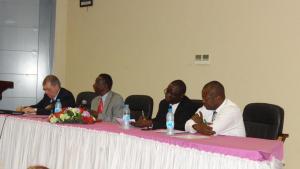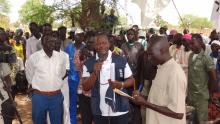South Sudan declares Rift Valley fever outbreak in parts of Eastern Lakes State
Juba, 12 March 2018 – The Ministry of Health and the Ministry of Livestock and Fisheries have declared a Rift Valley fever (RVF) outbreak today (12 March) in Yirol East, Yirol West and Awerial Counties of Eastern Lakes State.
The declaration was preceded by a joint high-level advocacy mission led by the Minister of Health, Dr Riak Gai Kok. The mission, comprised of representatives from the Ministry of Health, Ministry of Livestock and Fisheries, the World Health Organization (WHO), and the Food and Agriculture Organization of the United Nations (FAO), visited Yirol East on 6 March 2018 to consolidate response efforts and solicit more commitments by all stakeholders to contain the outbreak.
The RVF outbreak was first suspected in December 2017, following three deaths in humans with a history of severe hemorrhagic illness in Thonabutkok village, Yali Payam, Yirol East County, Eastern Lakes State. The initial case dated back to 7 December 2017. Abortions in goats and sheep; deaths/disease in goats and cows were also reported and epidemiologically linked to the human cases.
Following the reported cases and deaths, the Ministry of Health, and Ministry of Livestock and Fisheries with support from WHO, FAO and other human and animal experts, launched a multi-sectoral response, in the context of one health, for in-depth investigations to establish the exact cause of the reported deaths and illness in humans and animals.
Laboratory tests conducted by the Uganda Virus Research Institute (UVRI) confirmed that six human blood samples out of 34 collected were positive for Rift Valley fever. Also, one of the initial seven animal samples tested at UVRI was positive for Rift Valley Fever. Furthermore, 8 out of 21 samples collected from animals tested positive for RVF at the World Organization for Animal Health (OIE) reference laboratory in South Africa.
From 7 December 2017 to 9 March 2018, a total of 40 suspected human Rift Valley fever cases have been reported in the Eastern Lakes State. These have been reclassified based on investigations and laboratory results, as six RVF confirmed cases, three probable cases, and twelve suspected RVF cases (laboratory results are pending). Nineteen cases were discarded as non-cases following negative laboratory results for RVF and other common causes of viral haemorrhagic fever.
“Financial contributions from the European Union Humanitarian Aid (ECHO) and the United States Agency for International Development (USAID) allowed WHO to deploy experts and provide technical and logistical support,” said Mr Evans Liyosi, WHO representative a.i. to South Sudan.
WHO facilitated the establishment of a multi-sectoral rapid response to investigate and prevent further spread of the disease. WHO also moved to effectively coordinate the response and support State authorities with surveillance, risk communication, case management and logistics including prepositioning assorted medical supplies in Yirol East County.
A joint multi-sectoral contingency plan has been developed which will be fully rolled out in Eastern Lakes to ensure RVF is contained. This will involve intensified surveillance in both humans and animals, risk communication and case management.
RVF is a viral zoonotic disease that primarily affects animals, but also has the capacity to infect humans. People are infected with RVF virus through contact with blood, body fluids, or tissues of RVF virus-infected animals, mainly livestock. This direct contact with infected animals can occur during slaughter or veterinary procedures, like assisting an animal giving birth. Less commonly, people can be infected with RVF virus from bites of infected mosquitoes and, rarely, from other biting insects that have the virus on their mouthparts. Spread from person to person has not been documented.
Email: guyoa [at] who.int
Communication Officer (Health Promotion/Risk Communication focal person)
Mobile: +211 (0) 921647860
Email: luwagal [at] who.int
Communications Officer
Mobile: +211 921 647 859
Email: ebrahimj [at] who.int


